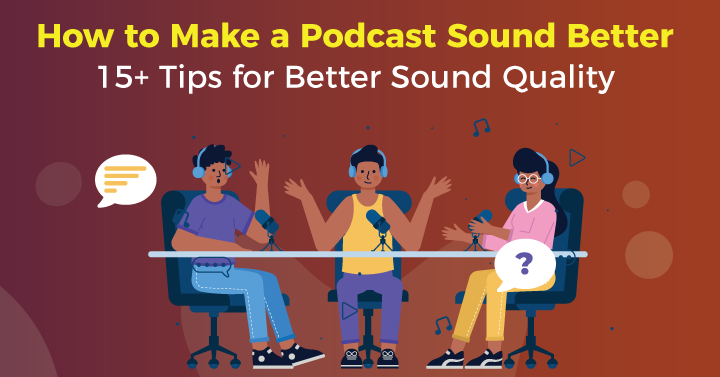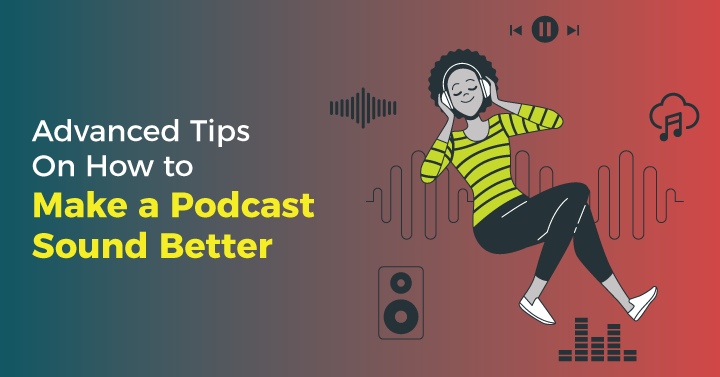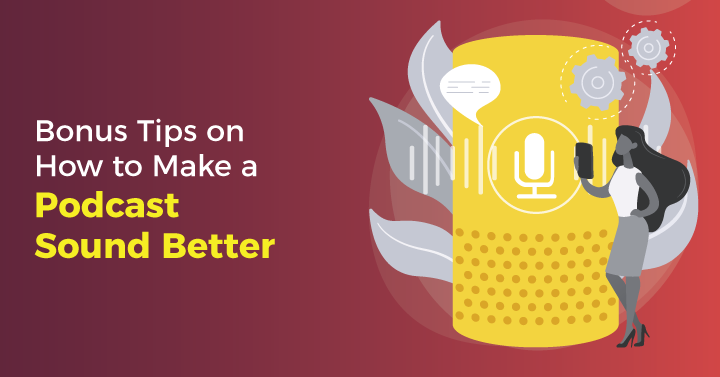
Creating a podcast is a fantastic way to share your voice and ideas with the world. But let’s face it, a poorly produced podcast with bad sound quality can quickly turn off listeners and make it difficult to gain traction. Sound quality is one of the most important aspects of a podcast, and it can be tricky to get it just right. If you want to captivate your audience and keep them coming back for more, it’s essential to know how to make a podcast sound better.
With a little creativity and some simple techniques, you can transform your podcast from mediocre to marvellous. Here are 15+ tips for getting better sound quality for your next podcast production.
1. Why It’s Important for a Podcast to Sound Good?
Production Quality
Having high production quality is one of the many important aspects of creating a successful podcast. A high-quality recording ensures that listeners are able to pick up on all the details and points made during the podcast. Additionally, poor audio levels and normalization (typical levels stick to -14 LUFs) can quickly turn away potential listeners, making it all the more important to ensure the sound is polished during post-production.
Engage Listeners
The sound quality plays an even more integral part in engaging listeners. If you want your audience to keep coming back to your podcast, create high-quality audio content. Having a well-balanced audio track allows individuals to be immersed in what is being discussed without distractions such as excessive noise reduction or background music.
Audio Consistency
Audio consistency is a crucial factor that can significantly enhance the quality of your podcast. By maintaining consistent podcast audio levels throughout your podcast, you can create a more professional and polished sound that will keep your audience engaged and attentive. Inconsistent audio levels can be jarring and distracting for listeners, making it difficult for them to engage with your content fully.
Build Credibility & Professionalism
Sound quality affects how people perceive you and your brand. If potential listeners hear your voice through headphones, they should not be distracted by echo effects or poor sound frequencies. Ensuring good audio quality, therefore, helps build credibility among audiences which reflects positively on your brand.
Appearance On Reputed Platforms
The audio quality of your podcast should be at its best if you want to submit your recordings to platforms like Apple Podcasts or Spotify. These platforms tend to place higher importance on technical standards for podcasts (in terms of volume allocation per speaker etc.). This also adds value to anyone trying to seek engagement from larger publications like New York Times Podcasts and BBC Radio which usually maintain significantly higher Sound Quality standards.
2. Basic Tips on How to Make a Podcast Sound Better
2.1 Invest in a Good Microphone
How to make a podcast sound better is a crucial question for anyone interested in creating a professional and engaging podcast. The first step is investing in good quality equipment, particularly a microphone that is suitable for your recording environment. Investing in a good-quality microphone is a great way to improve the sound quality of your recordings. It will provide a more accurate rendition of the sounds you are recording and ensure that your recordings are as close to their original source as possible.
Additionally, spending money on a quality microphone can save you time in post-production, as you won’t have to worry about getting rid of background noise or trying to clean up the audio recording. You’ll be able to achieve a higher level of audio quality and have greater control over the final result by investing in the best-quality microphone.
2.2 Choose a Quiet Recording Location
If you’re looking to create a successful podcast, it’s essential to understand how to make a podcast sound better. Choosing the right recording location can have a huge impact on your podcast. The ideal space should be quiet and without any distracting background noise. It should also be large enough to accommodate all of your equipment in order to ensure that the sound quality is as good as possible.
Acoustic treatment is also important to reduce echo, room reverberation, and other unwanted sound issues – adding acoustic sound absorption panels or using professional recording booths can drastically improve your recordings. Finally, ensure everyone in the recording space knows your needs and is practised with the best miking techniques suitable for podcasting.
2.3 Use Headphones to Monitor Audio
Using headphones while recording audio is a good way to ensure you are getting the best sound quality possible. You can hear exactly what your microphone is picking up, which allows you to make any necessary adjustments before moving forward with your podcast.
Not only does this help with sound quality, but it also helps create a more balanced mix without having loud and soft elements in the final product. Headphones also provide an extra layer of monitoring that speakers simply won’t be able to replicate and can give you the peace of mind that your recordings will be as good as possible.
2.4 Speak Clearly and Consistently
To make your podcast sound better and create an overall positive listening experience for your audience, it is important to speak clearly and consistently. Make sure you pronounce clearly all of the words in each sentence, use appropriate pauses between thoughts, select topics that are interesting and engaging, and practice speaking slowly.
Additionally, focus on using simple language that your listeners can easily understand. Keep in mind that often, a conversational style works best for podcasts. You want to make sure to keep your audience engaged while providing them with valuable content they will benefit from. Through clear and consistent communication, you can ensure that each episode maintains high-quality standards.
2.5 Edit Out Any Unwanted Background Noise
Audio editing is an essential step in producing a great-sounding podcast that will keep listeners coming back for more. The sound quality of your podcast is an important factor when it comes to making a good impression on your audience. The last thing you want is for background noises or irritating echoes to distract from your content.
Fortunately, using audio editing software like Audacity, you can edit out unwanted background noise and make your podcast sound better. With podcasting editing tools, you can adjust the volume, tweak equalization levels to reduce certain frequencies, and manipulate the recording until you have a perfect final result.
3. Advanced Tips On How to Make a Podcast Sound Better

3.1 Use a Pop Filter to Reduce Plosives
A pop filter is an essential tool for any podcaster. It prevents the sound of your voice from popping, hissing, and sometimes even overloading the microphone. In addition to making your audio easier on the ears, a pop filter reduces plosives (explosive sounds like Ps and Bs) from entering your recording.
This helps make your podcast sound much clearer, allowing you to focus more on creating compelling content. Pop filters are relatively inexpensive and simple to use, so if you’re looking to make a great-sounding podcast, then it’s definitely recommended that you invest in one.
3.2 Adjust Microphone Placement and Distance
Finding the optimal microphone placement and distance can have a huge impact on the audio quality of your podcast. Making sure that you have the microphone set at the right angle and distance from you will help to reduce background noise and maximize your voice’s clarity and volume.
For added protection against too much sound, consider using a windscreen to block out any unwanted sounds caused by plosives, sibilance, and wind. Once you are done positioning everything just right, it’s time to dive in and start recording your amazing podcast for the world to hear.
3.3 Use Equalization (Eq) To Balance Audio Levels
Equalization (Eq) is an essential process for creators in the podcasting industry, as it helps to balance podcast audio levels. This process can be used to reduce or boost specific frequencies, allowing the mixer to adjust levels based on the source material. You can use this technique to ensure that each element of the podcast sounds as good as possible.
By reducing or boosting different frequencies, you can achieve a balanced soundscape with clear audio that is easy to listen to. Additionally, equalization can also be used as a creative tool to give certain elements of your podcast more definition and presence.
3.4 Use Compression to Even Out the Volume
Podcasting audio compression can make a huge difference in the sound quality of your show. The compression evens out the volume of individual words so that listeners don’t have to adjust their volume knob if the speech level dramatically changes.
It also helps reduce background noise and make the spoken word more clear and more intelligible. Compression can help give your podcast a boost in sound quality, bringing it to professional podcast audio levels without having to shell out for expensive equipment or studio time.
3.5 Use Noise Reduction Tools to Remove Unwanted Sounds
In podcasting, noise reduction tools are essential. These tools help to improve sound quality by removing unwanted sounds such as background noise, hums, buzzes, and other low-level interference. Noise reduction tools help to reduce the amount of time spent editing audio by automatically removing noises so that you can focus on improving the sound of your podcast.
By minimizing these elements, you can make sure your podcast sounds professional and clear even when listened to through a wide variety of devices. With these tools, you can achieve higher levels of audio fidelity and improve the overall experience for your listeners.
4. Editing Tips for a Polished Podcast
4.1 Remove Any Dead Air or Long Pauses
Removing any dead air or long pauses from your podcast is a great way to improve its flow and overall quality. Listen to your recording and identify any long pauses or dead air you want to remove.
Adding filled-out audio, such as background music and sound effects, can enhance the listeners’ overall experience with the content. Listen to your podcast again to ensure the pacing is consistent throughout the episode. You don’t want to remove so much dead air that it feels rushed or choppy.
4.2 Edit Out Any Stumbles or Mistakes
Podcasts offer a great opportunity to reach listeners and build relationships. However, editing out stumbles and mistakes is a key factor in understanding how to make a podcast sound better. This ensures the podcast is polished and professional and provides top-notch content.
Editing can help ensure every episode meets standards of quality while also removing anything unnecessary or irrelevant to the topic at hand. Taking time to edit podcasts before releasing them can make a big difference in their quality and how people perceive them!
4.3 Add Music or Sound Effects Where Appropriate
Adding music or sound effects to your podcast can really boost the quality of your show. Music and sound effects can help set the tone for a segment, create emotion and tension, build suspense, generate interest, and enhance transitions.
In addition, thoughtful use of soundscapes can add credibility to your content. By picking relevant music or sound effects that complement your story, you’ll leave a lasting impression on your audience and help ensure their satisfaction with your content.
4.4 Use Transitions to Smooth Out Cuts Between Segments
Transitions, such as sound or music, are a great way to smooth out the cut between segments. When used correctly and at the right moments during a podcast, transitions can help create a better flow of ideas, enhance storytelling quality and even add humor.
Furthermore, adding quality audio elements to your podcast production will definitely increase your audience engagement and boost its chance of success. With some creativity and imagination, you can make these small edits work like magic to dress up your show.
4.5 Mix and Master the Audio for a Professional Finish
Mixing and mastering audio is a technique to get your podcast to sound professional. It involves levels, panning, compression effects, equalizing the sound, setting reverb levels, and other enhancements.
By mixing and mastering the audio for a podcast, you can ensure that your content is of the highest quality possible. Podcast audio processing ensures listeners don’t experience any unpleasant surprises when they press play on an episode – it also helps give your show consistency from episode to episode.
5. Bonus Tips on How to Make a Podcast Sound Better

5.1 Listen Back On Multiple Headsets
Listening back on different headphones can be one of the best ways to pick up on issues with clarity or consistency within your recordings. Some of the issues may not be immediately obvious when only listening through one device, like speakers. So, it is advised to listen through headphones to guarantee precise reproduction of each layer within a mix which leads to greater accuracy.
5.2 Opt For Better Monitor Speakers
Opting for better monitor speakers over computer speakers when listening back to your podcast can make a significant difference in the sound quality. When it comes to listening back to your podcast, the room’s acoustics can play a significant role in how the sound is perceived. Monitor speakers are designed to work in a wide range of room sizes and shapes, whereas computer speakers may not be optimized for your particular listening environment.
5.3 Experiment With Post-Production Software And Effects
Finally, if available, try experimenting with post-production software tools such as Adobe Audition which comes equipped with a large variety of special effects (equalization filters, panning, etc.). These tools can often improve even mastered material by intensifying certain parts like background music or vocal reverb, etc., so use them sparingly until we know what works best for our project’s original intent.
6. FAQs
- What Sound Settings Are Best for Podcasts?
The best sound settings for podcasting involve using a high-quality microphone and recording in a quiet environment with minimal background noise. It is also important to position the microphone close to the speaker’s mouth, set recording levels appropriately, and use EQ and compression to enhance the sound quality.
- How Do I Make My Podcast Sound More Natural?
Making a podcast sound more natural involves several key factors. Firstly, it’s important to use a conversational tone and avoid sounding scripted or rehearsed. Speak naturally, using pauses, inflection, and emphasis to add depth and personality to your voice. Secondly, include ad-libs and spontaneous moments that add authenticity and relatability to your content. Finally, editing should be done in a way that preserves the natural flow of conversation, with minimal cuts and adjustments to maintain the authenticity of the recording.
- How Do I Eq My Podcast?
EQing your podcast involves adjusting the levels of different frequencies in the audio to achieve a balanced and natural sound. To EQ your podcast, start by listening to the recording and identifying any frequencies that sound too loud or too quiet. Use an EQ plugin or software to adjust these levels, boosting or cutting frequencies as needed.
- How to Master Podcast Audio?
You can master podcast audio by taking measures like – using a good quality microphone, recording in quiet space, adjusting levels and EQ, and using compression.



